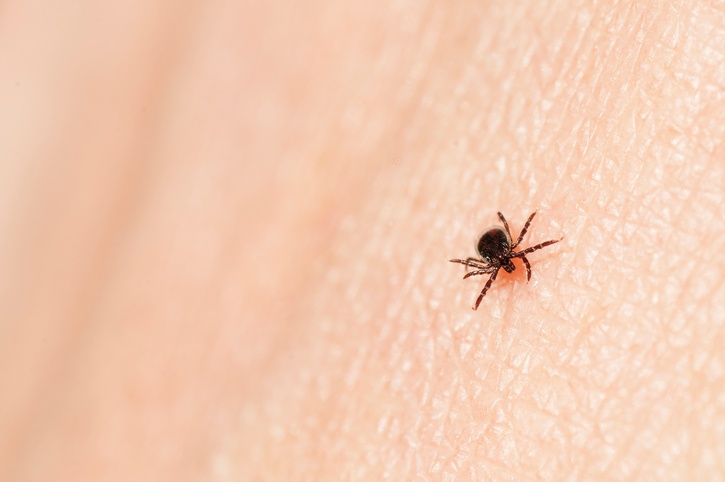
The weather is finally warming up and that means that you and your family will be getting outdoors as much as possible. However, that also means you may be spending time with some less favorable friends; deer ticks. Deer ticks and the Lyme Disease that they spread are something that everyone should be aware of. Knowing how it spreads, how to prevent it, what symptoms to look out for are key to avoiding a serious long-term problem. Here are five need to know facts about Lyme Disease with data sourced from the Center for Disease Control (CDC).
1. Lime Disease is Caused by Bacteria
According to the CDC, “Lyme disease is caused by bacteria called Borrelia burgdorferi and is transmitted to humans through the bite of infected blacklegged ticks. Typical symptoms include fever, headache, fatigue, and a characteristic skin rash called erythema migrans. If left untreated, infection can spread to joints, the heart, and the nervous system.”
2. You Have 36 – 48 Hours to Act
As stated by the CDC, “In general, ticks need to be attached for 36 to 48 hours before they can transmit Lyme disease bacteria.”
If you’re wondering if you should see a doctor, consider WebMD’s advice. You should see a doctor if any of the following criteria applies to you:
- “A tick is attached to your body and you are unable to remove the entire tick.
- You have a circular red rash that expands over the course of several days, especially if you know you were recently exposed to ticks. You may also have flu-like symptoms, such as fatigue, headache, stiff neck, fever, chills, or body aches.
- You feel very tired or have joint pain (especially with redness and swelling), irregular heartbeats, severe headache, or neck pain.
- You are pregnant or nursing and you think you may have been exposed to ticks.”
3. Ticks Have Favorite Spots
Though ticks can bite you anywhere, there are specific areas that they prefer, so you should pay strong attention to those areas. The CDC noted that, “Ticks can attach to any part of the human body but are often found in hard-to-see areas such as the groin, armpits, and scalp.”
4. The Nymphs are the Biggest Threat
Chances are if you live in New England that you’ve found and removed a tick from yourself or a loved one. It’s also more than likely that you’ve noticed a mature tick due to its size. However, the nympths or “immature” ticks are a bigger threat because they can hide easier. The CDC says, “Most humans are infected through the bites of immature ticks called nymphs. Nymphs are tiny (less than 2 mm) and difficult to see; they feed during the spring and summer months. Adult ticks can also transmit Lyme disease bacteria, but they are much larger and may be more likely to be discovered and removed before they have had time to transmit the bacteria.”
5. Ticks Aren’t Born with the Infection
While it’s easy to believe that ticks are simply born infectors, they aren’t. Per the CDC, “The complete life cycle of Ixodes ticks requires 2 years. Tick eggs are laid in the spring, and hatch as larvae in the summer. Larvae feed on mice, birds, and other small animals in the summer and early fall. The larvae may become infected with Lyme disease bacteria when feeding on these animals. Once a tick becomes infected, it stays infected for the rest of its life and can transmit the bacteria to other hosts.”
What You Can Do to Stay Safe
While there is no vaccine to prevent Lyme Disease, there are ways to prevent contraction of the bacterial infection.
Landscaping: If you are worried about contracting Lyme Disease around your home, you should consider landscaping in a dry way. Ticks need higher humidity to thrive, so creating dry space is a good solution to lessen their hold on your yard. The CDC noted, “Removing leaf litter and clearing tall grass and brush around houses and at the edges of lawns will reduce the numbers of ticks. Placing wood chips or gravel between lawns or play areas and wooded areas creates a dry barrier that is difficult for ticks to cross.”
Hire a Professional: If you have a serious tick population problem near your home, you can consider hiring a professional to use pesticides to remediate the problem. The CDC asserts that, “Pesticide application to residential properties should be supervised by a licensed professional pest control expert and should be conducted when nymphal tick populations are at their local peaks.”
Keep Your Defenses Up: When you go camping or your kids are playing in areas with long grass, make sure to protect yourselves. Make sure to cover up by wearing long sleeves and long pants tucked securely into socks. Per the CDC you should, “Spray repellent containing a 20% concentration of DEET on clothes and on exposed skin. You can also treat clothes (especially pants, socks, and shoes) with permethrin, which kills ticks on contact, or buy clothes that are pre-treated. Permethrin can also be used on tents and some camping gear.”
Constant Vigilance: It’s important, particularly during the warmer months to check yourself for ticks each time you come back into your house after being outdoors. The CDC recommends the following: “Inspect all body surfaces carefully, and remove attached ticks with tweezers. Avoid crushing the tick’s body. DO NOT use petroleum jelly, a hot match, nail polish, or other products. Grasp the tick firmly and as close to the skin as possible. With a steady motion, pull the tick’s body away from the skin. Do not be alarmed if the tick’s mouthparts remain in the skin. Cleanse the area with an antiseptic.”
Know the Signs of Infection: The CDC notes the following as early stage signs of Lyme Disease: a characteristic skin rash, called erythema migrans, fatigue, chills and fever, headache, muscle and joint pain and swollen lymph nodes.
They note later stage signs as:
- “Arthritis is most likely to appear as brief bouts of pain and swelling, usually in one or more large joints, especially the knees.
- Erythema migrans (bull’s eye) rash.
- Nervous system symptoms can include numbness, pain, nerve paralysis (often of the facial muscles, usually on one side), and meningitis (fever, stiff neck, and severe headache).
- Rarely, irregularities of the heart rhythm may occur.
- Problems with memory or concentration, fatigue, headache, and sleep disturbances sometimes persist after treatment”
—
Prevention is the best way to stay safe from Lyme Disease, but action is important if you think you or another person close to you may be infected. If you think that you have contracted Lyme Disease, please contact a provider at Derry Medical Services.

